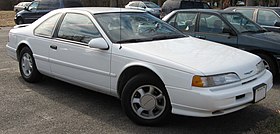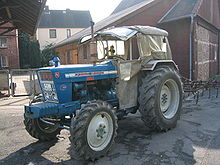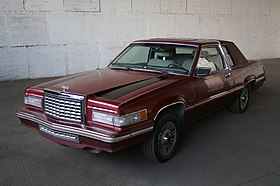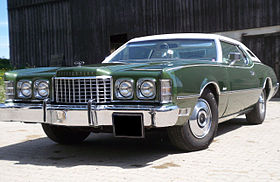Tenth generation Ford Thunderbird
 |
| Manufacturer | Ford Motor Company |
|---|
| Production | October 1988–September 1997 |
|---|
| Assembly | Lorain, Ohio
Wixom, Michigan |
|---|
| Predecessor | Ford Thunderbird (ninth generation) |
|---|
| Successor | Ford Thunderbird (eleventh generation) |
|---|
| Body style | 2-door coupe |
|---|
| Layout | FR layout |
|---|
| Platform | Ford MN12 platform |
|---|
| Engine | 3.8 L Essex V6 (1989–1997)
3.8 L Essex Supercharged V6 (1989–1995 Super Coupe only)
4.9 L (302 cu in) Windsor 5.0 V8 (1991–1993)
4.6 L Modular V8 (1994–1997) |
|---|
| Transmission | AOD 4-speed automatic transmission(1989–1993)
4R70W 4-speed automatic transmission (1994–1997)
M5R2 5-speed manual transmission(1989–1995 Super Coupe only) |
|---|
| Wheelbase | 113. in (2,870 mm) |
|---|
| Length | 1989–1993: 198.7 in (5,047 mm)
1994–97: 200.3 in (5,088 mm) |
|---|
| Width | 1989–1995: 72.7 in (1,847 mm)
1996–97: 73.2 in (1,859 mm) |
|---|
| Height | 1994–97: 52.5 in (1,334 mm)
1994–95 Super Coupe: 53.0 in (1,346 mm)
1989–1993: 52.7 in (1,339 mm)
1991–93 Upper End Model: 53.1 in (1,349 mm) |
|---|
| Curb weight | 3,536 lb (1,604 kg) (1989 V6 model)
3,725 lb (1,690 kg) (1995 V8 model) |
|---|
| Related | Lincoln Mark VIII
Mercury Cougar |
|---|
On December 26, 1988 a completely redesigned Thunderbird was introduced as a 1989 model alongside its sister car, the Mercury Cougar.Developed on Ford's new MN12 (Mid-Size North American Project 12) platform, the new Thunderbird featured a more aerodynamic body that was slightly shorter in overall length relative to the 1988 Thunderbird but had a nine inch longer wheelbase. The car featured a short-long arm (SLA) four-wheel independent suspension, with a modified MacPherson strut assembly in front, that offered excellent handling and ride quality. This setup was significant as it made the Thunderbird and the Cougar the only rear-wheel drive North American domestic cars other than the Chevrolet Corvette to offer a four-wheel independent suspension at the time. Engine options fell to only two for 1989 as Ford dropped the V8 option for the new Thunderbird. The base and LX models were powered by Ford's 3.8 L Essex OHV V6. Producing 140 horsepower (100 kW) at 3800 rpm and 215 lb·ft (292 N·m) of torque at 2400 rpm, many felt the engine was somewhat underpowered for a car that weighed over 3,500 pounds (1,600 kg) in base trim (heavier when equipped with available options). This engine was mated to Ford's AOD 4-speed automatic transmission regardless of trim level from the 1989 to 1993 model years. Thanks in part to its low coefficient of drag, the Thunderbird was relatively fuel efficient considering its overall size and weight. The EPA gave 1989 Thunderbirds equipped with the standard V6 a fuel efficiency rating of 19 mpg-US (12 L/100 km; 23 mpg-imp) in city driving and 27 mpg-US (8.7 L/100 km; 32 mpg-imp) on the highway, though, like most cars built before 2008, this rating was retroactively reduced by the EPA to reflect newer, more realistic fuel efficiency measurements.The fuel efficiency rating was noticeably better than that of Thunderbirds equipped with higher performance engines and gave the base V6-equipped Thunderbird a significant driving range with its 19 gallon fuel tank (later decreased to 18 gallons).
A more sophisticated, supercharged and intercooled version of the 3.8 L OHV V6 was used to power the high performance Thunderbird Super Coupe, also called Thunderbird SC for short. The Super Coupe could be had with a Mazda-derived,M5R2 5-speed manual transmission or an AOD 4-speed automatic transmission. The Thunderbird Super Coupe was Motor Trend's Car of the Year for 1989, which Ford proudly advertised. When running at a maximum of 5600 rpm, the supercharger provided 12 psi of boost, producing 210 horsepower (160 kW) at 4000 rpm and 315 lb·ft (427 N·m) of torque at 2600 rpm under a 8.2:1 compression ratio. Accompanying the more powerful engine, Super Coupes were equipped with a host of unique features underlining their higher performance demeanor relative to standard Thunderbirds. Among these were larger, 16 x 7.0 inch alloy wheels with high performance tires (standard Thunderbirds came with 15 x 6.0 inch steel wheels and 15 x 6.5 inch alloy wheels were optional), a Traction-Lok limited slip differential, standard anti-lock brakes, 4-wheel disc brakes (vented front and rear rotors), speed-sensitive variable assist steering, lower body side cladding, fog lights, and a stiffer suspension with adjustable shocks supplied by Tokico.
In spite of the new Thunderbird's merits, it was considered a failure by Ford's top management. On January 17, 1989, Ford President Harold A. Poling, with Ford CEO Donald Petersen and Ford Executive Vice President Phil Benton looking on, lambasted the MN12 program's staff in a meeting for badly missing the Thunderbird and Cougars' weight and cost targets (250 lb (110 kg) heavier and $900 US$ more per car than planned). This criticism came as a surprise to the program staff who expected to be praised for the Thunderbird and Cougars' technical achievements and positive reception. Anthony "Tony" S. Kuchta, manager of the MN12 program, was angered by Poling, not for his points about weight and cost overruns but rather that he directed his tirade at the program staff instead of at Kuchta who was responsible for all of the important decisions that determined the program's direction. Ironically, many of the decisions that Kuchta made regarding the MN12's development that resulted in the weight and cost overruns criticized by Poling were caused by the very things that set the MN12 cars apart from other cars in their class (such as rear-wheel drive and an independent rear suspension). Falling out of favor with Ford management after the Thunderbird and Cougars' launch, Kuchta voluntarily retired early from Ford in May 1989.
For the 1991 model year, Ford reintroduced a V8 option with the 4.9 L (302 cu in) Windsor 5.0 V8. The engine was used through the 1993 model year and produced 200 horsepower (150 kW) at 4000 rpm and 275 lb·ft (373 N·m) of torque at 3000 rpm; gains of 35 horsepower (26 kW) and 25 lb·ft (34 N·m) of torque respectively over the 1988 Thunderbird, the previous Thunderbird to use this engine. Like the standard 3.8 L V6, the V8 was only mated to the AOD 4-speed automatic transmission. On the television program MotorWeek in a review of the 1991 Thunderbird and similar Mercury Cougar, a road test of a V8-equipped Thunderbird revealed that the car could accelerate from 0 to 60 mph in 9.2 seconds; approximately two seconds faster than a standard V6 Thunderbird but about two seconds slower than a Super Coupe.
1994

1994 Ford Thunderbird LX (with aftermarket headlights)
In 1994, the Thunderbird received some exterior updates. The front fascia saw substantial stylistic changes with larger air scoops in the bumper cover, new headlamps, and a new, slightly more curvaceous hood. At the center of this, the silver Thunderbird logo was moved onto the front bumper cover from the front lip of the hood where it was located previously. The Thunderbird's interior was completely redesigned with an emphasis on optimizing driver comfort and convenience to the utmost. The redesign featured a "wrap around" cockpit-style layout of instrumentation with a new steering wheel, radio, and climate controls and sweeping curves on the door panels and dashboard surfaces. Complementing the changes to the interior came added driver and passenger safety as Ford made dual front-side airbags standard on all 1994 Thunderbird models.
Arguably the most dramatic change for 1994, however, was the new 4.6 L Modular SOHC V8 which replaced the "5.0" Windsor engine. The 4.6 L V8 produced 205 horsepower (153 kW) at 4500 rpm and 265 lb·ft (359 N·m) of torque at 3200 rpm and brought with it an updated powertrain control module, the EEC-V (base V6 Thunderbirds and Super Coupes continued to use the older EEC-IV). An electronically-controlled 4R70W 4-speed automatic transmission replaced the AOD automatic transmission in all instances where it was previously used in the Thunderbird. Car and Driver reviewed the 4.6 L V8 and it managed a 0 to 60 mph acceleration time of 8.1 seconds and a quarter-mile being completed in 16.3 seconds at 87 mph.
The Super Coupe continued on in 1994 with the same supercharged 3.8 L V6 as before, but now with 230 horsepower (170 kW) at 4400 rpm and 330 lb·ft (447 N·m) of torque at 2500 rpm. This was made possible due to a number of changes. The
Eaton M90 roots-type supercharger was given a larger, square style inlet, a larger attaching inlet plenum, and Teflon coated rotors. The engine received larger fuel injectors and an increase in compression to 8.6:1. In their March 1996 issue,
Motor Trend magazine conducted a comparison test of a 1995 Thunderbird Super Coupe against the front-wheel drive Chevrolet Monte Carlo Z34 and a Buick Regal Gran Sport. The Super Coupe delivered the best overall performance, including a 0 to 60 mph acceleration time of 7.0 seconds and a completion of a quarter-mile in 15.2 seconds at 88.1 mph. In summarizing the overall performance of each car relative to each other, the author of the article, Don Sherman, wrote, "The Buick Regal is a competent, comfortable car at an attractive price, but it's too androgynous to be called a Gran Sport. Nothing about it is grand, and there isn't a sporting bone in its body. All the Monte Carlo needs to succeed is a V-8 engine and a year of refinement to eradicate its quality bugs. That leaves the Thunderbird SC as this test's big winner. It's a far more sophisticated solution to the four-place-coupe equation, but is priced accordingly." In spite of positive critiques like this, the increases in output and performance over earlier Super Coupes would be short-lived, as the Thunderbird Super Coupe was discontinued after the 1995 model year due to slowing sales.
1996

1996–1997 Ford Thunderbird LX
For the 1996 model year, the Thunderbird received its last refresh. Available in LX (V6 or V8) or Sport (V8 only) trims, the cars received redesigned headlights, smoother front and rear fascias, body side cladding, and differently styled wheels (15 inch on LX, 16 inch on Sport). The car's taillights were revised with the black paint on the bottom quarter of the lenses being removed (previously, this paint was put on the taillights of LX Thunderbirds but omitted on the Super Coupe). The Thunderbird nameplate, which was previously positioned over this black paint on the driver side taillight, was moved above the taillight and its font was changed to a new, italicized style. With the revised front fascia, a small, egg-crate style grille (with the silver Thunderbird logo at its center) was added, giving the Thunderbird a traditional grille for the first time since the mid-1980s. The hood was redesigned with a slight bulge, which was necessary to fit the updated 4.6 L engine's taller intake manifold, now composite. The V8 models were tuned to make 280 lb·ft (380 N·m) of torque at 3000 rpm, an increase of 15 lb·ft (20 N·m) of torque over the 4.6 L V8s used in 1994 and 1995 Thunderbirds, the horsepower however still remains the same at 205 horsepower (153 kW) at 4250 rpm. In another comparison test conducted by Motor Trend against a Monte Carlo Z34, a Thunderbird with the updated 4.6 L V8 accelerated from 0 to 60 mph in 7.9 seconds and completed a quarter-mile run in 15.8 seconds at 88.4 mph. Unfortunately for owners, the all-composite intake had a tendency to crack and leak antifreeze. Some 1997s are covered by a class action lawsuit settled by Ford late in 2005 (see Intake Manifold Defect for details). The base LX model continued to use the 3.8 L V6 as its engine but now made use of the EEC-V computer which before was only found in 4.6 L V8-equipped models. Torque output from the V6 remained the same as before at 215 lb·ft (292 N·m) (though at 2750 rpm versus 2400 rpm) but power increased to 145 horsepower (108 kW) at 4000 rpm for 1996.
1997
In 1997, Ford made few notable changes, trying to save as much money as they could on the floundering coupe. On the exterior, the Thunderbird logo in the grille on early 1997 Thunderbirds have turquoise feet. However, late production 1997 models do not have these turquoise feet because Ford ran out of the inserts and decided not to go to the trouble of adding them to a car that was about to be discontinued. Also on some late 1997 models, the seven-spoke, 15x6.5-inch alloy wheels available on LX models of the 1993, 1994, and 1995 Thunderbirds briefly returned with a chrome finish instead of with the silver paint used originally. The wheels were left over from the earlier model years and, with their new finish, were made available as a special option near the Thunderbird's discontinuation. Inside, the instrument cluster was changed from a six gauge layout (speedometer, tachometer, fuel, coolant temperature, oil pressure and voltmeter) to a four gauge layout (speedometer, tachometer, fuel, coolant temperature), similar to that previously used on the Ford Taurus and Mercury Sable of the time. Lastly, the Thunderbird's options list was abbreviated to a power sunroof, power driver seat, remote keyless entry, and a CD player.
Toward the end of the MN12 Thunderbird's production run, Ford's Special Vehicle Engineering (SVE) division explored the idea of a new high performance Thunderbird, producing four prototypes. Stylistically the SVE Thunderbirds blended elements from the 1994–1995 and 1996–1997 Thunderbirds along with elements unique to themselves. The SVE Thunderbird used the headlights, door handles, and rear bumper cover from the 1994–1995 Thunderbird and front fascia and body side cladding from the 1996–1997 Thunderbird. Unique to the SVE Thunderbird relative to other Thunderbirds were 17-inch, five spoke Cobra R wheels, larger dual exhaust tips, a different lower section of the front fascia with fog lights, a unique spoiler, and a prominent cowl hood. The most significant difference that set the SVE Thunderbird apart from other Thunderbirds was its supercharged 4.6 L DOHC V8 engine, similar to that later found in the SVT Mustang Cobra. Power was delivered to the wheels via a Tremec T-45 5-speed manual transmission. Stopping the SVE Thunderbird were larger brakes taken from the Mustang Cobra (going along with its Cobra R wheels). In spite of its potential, this high performance Thunderbird was not meant to be as Ford not only pulled the plug on this project, but on the entire Thunderbird and Cougar line, with the 1997 model year being its last. On September 4, 1997, the final MN12 Thunderbird was built at Ford's assembly plant in Lorain, Ohio. As it rolled down the assembly line, a sign saying "That's All Folks" adorned the decklid.
Production Totals
| Year | Production |
| 1989 | 122,909 |
| 1990 | 114,040 |
| 1991 | 84,719 |
| 1992 | 74,149 |
| 1993 | 130,750 |
| 1994 | 121,082 |
| 1995 | 115,397 |
| 1996 | 112,302 |
| 1997 | 36,583 |
| Total | 961,624 |




















![Validate my RSS feed [Valid RSS]](valid-rss-rogers.png)














































































